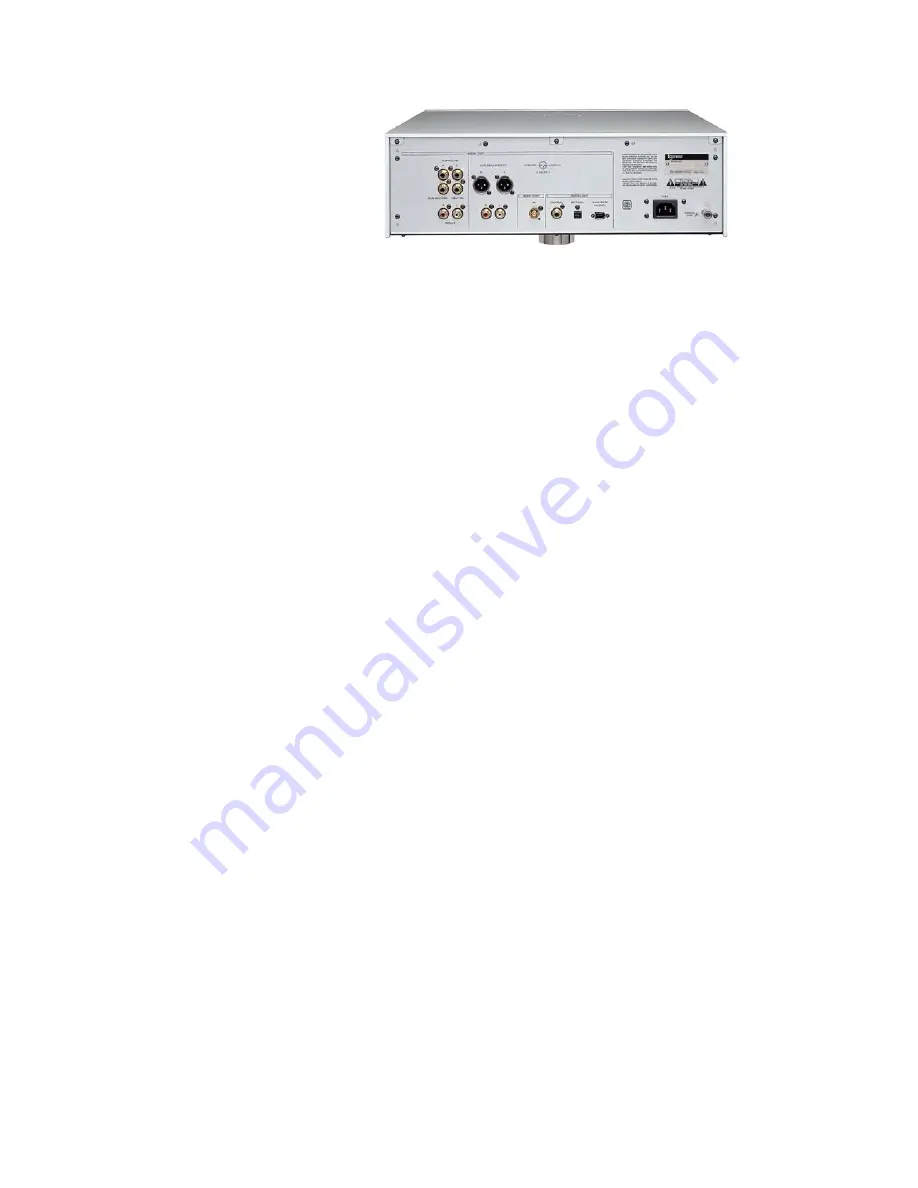
The central black area contains the door
for the transport mechanism and a screen
designating the play mode, track, time, etc.
The six buttons on the right are for the
standard transport controls. The back has
six gold RCA's for surround output, two gold
RCA's and two gold XLR outputs for two
channel single ended and balanced output,
and digital RCA and Toslink output for PCM
up to 24-bit/96kHz two track (192kHz and
176kHz down converted to 96/88 kHz) and DD-DTS 5.1. The unit can also take a DD or DTS or DVD-Audio
signal, re-encode it to two-channel PCM similar to Dolby Pro-Logic and send it out to a pre-pro receiver for
surround decoding through either the 2-channel analog or the digital outputs. In the setup, one must opt for two-
channel rather than multichannel output for this to function. This would be helpful for the few of us who haven't
upgraded to a receiver with 5.1 analog inputs for DVD-Audio decoding. It actually does a very good job of it,
especially with my Lexicon MC-12 using its proprietary Logic 7 decoding, but Dolby Pro-Logic or DTS Neo-6
should work equally well. While its not true 5.1 separate channels, the results are far superior to just taking the
front two channels and trying to get ambiance information from them.
A FireWire output is available for those pre-pro/receivers that can do external D/A conversion of DVD-Audio or
SACD if one wishes to use the unit as a transport. There is also a BNC input to sync the word clock with an
external decoder or word clock generator. Finally there's an IEC and ground plug, with a pretty good line cord.
The remote control weighs more than some players and is made of a solid aluminum block that feels expensive.
The major buttons are backlit for ease of use in darkened listening rooms and are well laid out. The only thing
missing is the ability to change the upsampling on the fly as this would be very convenient as one disc may
sound best with one type, while another is best with a different sampling rate. Except for that, setup is very
simple using the remote, but several of the setups, such as individual speaker loudness and distance or total
volume of the system can't be adjusted while playing a disc. The booklet was very instructive and well written in
the King's English, being very clear in its format, although there are a couple of descriptions of functions that
leave a little to be desired as to how they should affect the playback. The unit comes in huge thick double
cardboard boxes with a total weight of over 44 pounds, so be careful of your back.
Other than the massive cabinet built for both ruggedness and vibration abatement, there are two advances that
I think make this unit a winner.
First is the VOSP transport mechanism. As you may be able to make out from the picture, the mechanism is
very different from others, with the pickup resting on two aluminum rods along which it can move just like a
straight tracking tonearm. In addition it can rotate and move up and down, eliminating off-axis tracking with its
subsequent decreased error correction that may distort how the laser reads the pits. Remember that information
retrieval is actually an analog system, reading the distance between the beginning and ending edges of the pits
to determine the bit information. If the turntable rotation is wobbly or intermittently faster or slower, then the pits
will look slightly larger or smaller. Thus the differences heard between transports and discs may not be a
function of loss of bits, but just a change in their numerical value or the timing of when they are read.
Also, as the unit reads the pits from the inside to the outside of the disc, the turntable must continuously slow
down. Then, the reading head, as it jumps from track to track, cannot be jerky in any way. As the arm is acting
like a straight tracker, there is less chance for it to be reading the track obliquely. The disc is on a circular
flywheel platform of high mass that stabilizes both the rotation and vibration of the disc. All of these things
reduce resonances and vibrations that make the reading of the disc more accurate, thus cutting down on the
need for even basic error correction.
Second, there's the digital signal processing. The unit uses three Cirrus Logic 4398 chips for D/A conversion,
and can do upconversion of anything up to 192 KHz in the two main channels of PCM. With its Finite Impulse
Response Filter (FIR), it upsamples to 8 times the original frequency before D/A conversion and with the
Refined Digital Output Technology (RDOT) that goes up to 32 times. In addition, PCM audio can be converted
to DSD.
Before D/A conversion, the unit upconverts the signal as follows:
1.
FIR 8X: 16/44-48 to 24/352-384Hz, 16-24/88-96 to 24/704-768Hz, and 16-24/176-192 to 24/1408-1536Hz
2.
RDOT & FIR 32X: 16/44-48 to 1408-1536Hz
3.
In addition, 16/44-48Hz signals can be converted to DSD at 1-bit/64X precision























